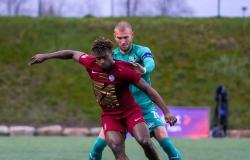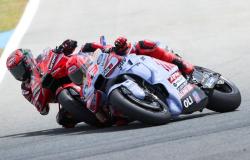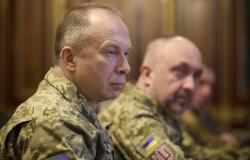“About people and the space where people live” – this will be the final message that, starting from March 22, every visitor to the Rothko Museum in Daugavpils will be able to read at the newly opened final exhibition of the International Latgale Graphics Symposium.
The Latgale Graphic Symposium is a meeting and networking platform for internationally recognized graphic artists, which this year took place from March 8 to 22 and brought together graphic artists from all over the world in Daugavpils for the twelfth time.
Getting to know the Daugavpils fortress and the urban environment, as well as visiting the cultural sites of Latgale, artists from Poland, France, Croatia, Italy, Estonia, Latvia and Taiwan created works of art, marking their individual handwriting and showing the wide technical diversity of the graphic medium.
When asked what makes this 12th International Latgale Graphics Symposium special and what can be enjoyed at its final exhibition, the director of the Rothko Museum, Māris Čačka, answers: “An amazingly friendly team has gathered for this graphics symposium this time during the selection round of the competition.”
The diversity of the graphic medium, the ways of its expression, which characterize this year’s symposium, will certainly intrigue fans of graphic art, says Čačka, whom I met after an interview with Czech television, which indicates the wide international interest of this event in Daugavpils. The graphics symposium culminates with the final exhibition.
“In the final exhibition, the gravure technique dominates, for the first time in these 12 years a work will be created in the mezzotint technique by a Taiwanese artist, then there will be a series of etching and aquatint works, and Lithuanian artists work in linocut, but the colored etching is in the works of an Estonian artist.
The exhibition as a whole will be interesting and promising. It will tell about people and the space in which people live in two big groups. This will be the final message that the artists have felt here for two weeks, both in the fortress environment, influenced by Krāslava, which we have visited, and the environment of Daugavpils and the people they have met,” says the director of the Rothko Museum.
In the artists’ workshops in the Daugavpils fortress in the last days before the end of the symposium, when I arrive here together with Māri Čačka and the charming interpreter of the Rothko Museum, Inga Gedžunis, there is an artistic buzz. First we meet Edvin Dragičević (Edvin Dragičević) from Croatia:
“I am here because as an artist I am attracted by the idea of working in different spaces, where I can work creatively side by side with other artists and try something new. I work in this symposium in the etching technique, etching zinc plates. The symposium takes place in Daugavpils, right in the fortress. Fortress the theme was already represented in my artwork, but now I am right there – in the fortress itself, so these impressions are even more vivid and vivid, and it appears even more in my works.
International Latgale Graphics Symposium. Croatian Edvin Dragičević.
Photo: Silvija Smagare / Latvian Radio
I am quite conservative, classic in my expression, there are many lines in the etching technique in my works. My works are basically figurative with some individual elements of abstraction. I used only two colors – red and black. Meanwhile, my other colleagues here are amazing colorists who do graphics and use a lot of color, which I really admire.”
Estonian artist Kadri Toma also works in the etching technique (Toom shots), only her works are already full of color, but the ideas in them were also drawn here – in the Daugavpils fortress.
“Usually I work in different techniques, I often use a mixed technique, but here I wanted to try something new. At the symposium, I create works in the etching technique, which I combine with paint. I think that my works at the exhibition will stand out among the works of my colleagues, because there are many Until now, I have used architectural details in my artwork, so Daugavpils inspired me a lot.
The architecture of Daugavpils is very interesting, to a certain extent alive and breathing, because it ages, turns into ruins here and there, nature enters the urban environment.
I think you will see echoes of all this in my works at the exhibition.”
International Latgale Graphics Symposium. Estonian Kadri Toma.
Photo: Silvija Smagare / Latvian Radio
The nature of Daugavpils and the urban environment itself did not leave Italian graphic artist Lorenzo Natali indifferent (Lorenzo Natali), who works in a special technique, using a computer to create works.
“My technique is a drawing of a system created on a computer. The natural elements that I let the computer speak about are very important in my artwork. My artwork shows that a robot can also speak the language of nature.
My first work, which I created for the exhibition, is a leaf of a plant that I found and picked up right here in Daugavpils Park. I let the computer convert it and let the computer speak the natural language. The second work is with landscape elements, it is Daugavpils in perspective. The work was done with a pencil and then with a computer. Daugavpils seemed to me quite flat as a place, and I modified it a little, added a little more hills.”

International Latgale Graphics Symposium. Italian Lorenzo Natali.
Photo: Silvija Smagare / Latvian Radio
The furthest path to the Latgale Graphics Symposium organized by the Rothko Museum in Daugavpils was measured by Peili Juana (Peili Huang) from Taiwan, her works in this exhibition, as the artist herself says, will bring a little oriental breath:
“I am the first Taiwanese artist to participate in this symposium in 12 years. I work in the mezzotint technique, in which the work is created with a special cutting tool that has an extremely fine tip. In this way, the necessary indentation is obtained on the material plate. One work is a copper engraving. I I continue what I started in Taiwan and work here in the same style.

International Latgale Graphics Symposium. Peili Juana. Taiwan.
Photo: Silvija Smagare / Latvian Radio
I hope that in this exhibition, which will be our joint work, our final result, I will be able to bring such a peculiar breath of the East, introduce people to Eastern graphics and encourage them to learn more about it.”
On the other hand, the breath of French graphics is introduced in this symposium by Pascal Pignon Jaffe (Pascal Pignon Jaf), also here the communication of the translator is perfectly performed by Inga Gedžune.
“In France, I work both as a graphic artist and as a sculptor and painter, but here I am a graphic artist and create monotypes. I highly value this symposium as a great opportunity to work freely, unforced, calmly, far away from all everyday cares and worries. it’s also a wonderful opportunity to work alongside other wonderful artists who are so diverse, it’s our diversity that makes the symposium such an enriching experience.

International Latgale Graphics Symposium. Pascal Pignon Jaffe. In France.
Photo: Silvija Smagare / Latvian Radio
In addition to being an artist, I also work in psychoanalysis, so as an artist I work with my subconscious. The works I make are impressions, impressions from the places I visit. I am currently in Daugavpils, and in every place I am attracted by the light, the buildings, the atmosphere. All this can be seen in my works here,” says the French artist.
France is also represented at this symposium by Vitalija Samuilova, a graphic artist born in the neighboring country of Lithuania (Vitalia Samuilova). She works in the etching technique with metal:
“I really like working with metal, I like to scratch it, to acid-etch it. When working in linocut or woodcut technique, we as graphic artists think in white lines, but my technique involves thinking in black lines, and that is something special.”

International Latgale Graphics Symposium. Vitaly Samuilova. In France.
Photo: Silvija Smagare / Latvian Radio
Polish artists Magda Šplita (Magda Szplit) and Henrik Krolikowski (Henryk Krolikowski).
They say: “We were very impressed by the visit to the historical hospital of the Daugavpils fortress, and you will definitely see the motifs of the hospital in our exhibition works.

Photo: Silvija Smagare / Latvian Radio

Photo: Silvija Smagare / Latvian Radio
I look for structure in my works, I am inspired by architecture – the old and the new. In my artwork, I seem to create a new perspective, which allows me to look at perhaps familiar, old things in a different way.”
Also at the Rothko Museum, the graphic symposium is complemented by the Latvian artist from Daugavpils, Oksana Vronska, and Poland is also represented by Anna Klosa (Anna Kłos), whose works can currently be seen in a personal exhibition in Daugavpils Poļu nama.
“I make my collages with scissors, cut and glue, use old newspapers, letters and also stamps. The main element in all my works is typography. I include fragments of the past in the collages, and in this sense the Daugavpils fortress inspired me a lot,” reveals the artist from Poland.

International Latgale Graphics Symposium. Polish woman Anna Klos and her works.
Photo: Silvija Smagare / Latvian Radio
The exhibition “Time” of the final works of the International Latgale Graphics Symposium will be available to visitors at the Rothko Museum in Daugavpils until May 19.
Tags: Etch scratch cut carve International Latgale Graphics Symposium exhibition opens Rothko Museum Article
-













